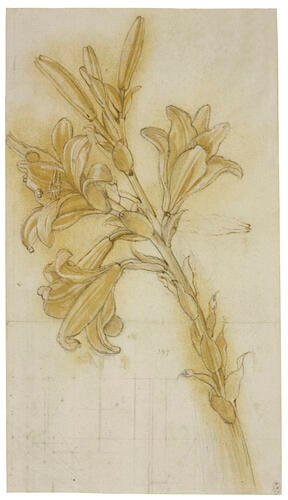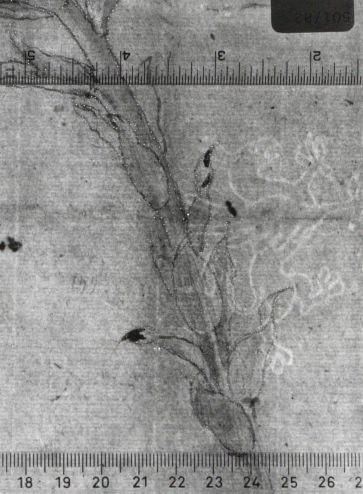-
1 of 253523 objects
A lily c. 1475
Stylus, pinpointing, leadpoint, pen and ink, brown wash, ochre wash and rubbing, white heightening (partly discoloured), pricked through. | 31.4 x 17.7 cm (sheet of paper) | RCIN 912418

Attributed to Andrea del Verrocchio (c.1435-88)
A lily c. 1475
Royal Collection Trust/© Her Majesty Queen Elizabeth II 2014



-
A drawing of a lily (Lilium candidum L.). The elaborate technique combines detailed underdrawing in leadpoint, a thick but varied pen line, modelling with dilute ink and ochre wash, an almost dry ochre rubbed into the paper, and highlights in liquid white lead. A bud was scraped out at center right, and the outlines of the lower stem and open blooms were pricked through for transfer. The closed buds above are drawn more rapidly in a slightly paler ink, and not pricked; they may have been an afterthought, for that portion of the stem does not join convincingly to the central branching. An undecipherable perspectival construction occupies the lower part of the sheet, with related ruled lines and pinholes toward the top of the lily.
The drawing was apparently among the loose sheets bequeathed by Leonardo da Vinci in 1519 to his pupil Francesco Melzi, for it bears Melzi’s later numbering 199. Scholars have been almost unanimous in accepting the work as Leonardo’s, and placing it among his earliest drawings, of the 1470s; only Pietro Marani ( ‘Una natura morta di Leonardo nella Milano di fine Cinquecento’, in La natura morta al tempo di Caravaggio, Rome 1995, p. 32) has proposed a later dating, placing it at the end of the fifteenth or start of the sixteenth century. Marani suggested a connection either with a Saint Anthony (mentioned in Leonardo’s notebook MS I, c. 1497, as a possible subject for an altarpiece for Brescia) or with an early stage of Leonardo’s composition of the Angel of the Annunciation, conceived in about 1505 and known through studio works and copies).
Plants or flowers appear in all of Leonardo’s early paintings, and ‘many flowers copied from nature’ are among a list of drawings made probably when he relocated to Milan in about 1482 (‘Molti fiore ritratti di naturale’; Codex Atlanticus, fol. 324r). But as Kenneth Clark noted as early as 1935, ‘the style of this drawing is quite unlike that of Leonardo’s other botanical drawings’ (A Catalogue of the Drawings of Leonardo da Vinci at Windsor Castle, Cambridge 1935, I, p. 56). Indeed, the technique, especially the pen line, is unlike any of Leonardo’s early studies. During the 1470s, his descriptive drawings, such as those of animals for the earlier Adoration, were mostly drawn with a hesitant, even timid pen line. His imaginative drawings were often done with a thicker pen handled more fluently, such as the Madonna and Child in the Louvre (inv. RF486) or the angel’s sleeve for the Annunciation (Oxford, Christ Church Picture Gallery). But when Leonardo slowed down with a thick pen, the results tended to be abrupt and clumsy - for example, the early double-sided sheet of profiles in the Uffizi (inv. 449E).
Leonardo’s earliest drawings do not feature the bold, confident line seen here, with the artist taking his time to model the contours and suggesting three-dimensional form. Though there is no direct parallel in the few known drawings by Verrocchio, this penwork is close to that in his Head of an angel (Uffizi, inv. 130-E) and the double-sided Study of putti (Louvre, inv. RF2). The flickering line of the leadpoint underdrawing also bears close comparison with Verrocchio’s Project for a Funerary Monument for Doge Andrea Vendramin (V&A, inv. 2314), very different from the scatchy leadpoint of Leonardo’s early drawings, such as the studies at Windsor for the Adoration (RCIN 912362) and of Dragons (RCIN 912370). Just as significantly, the complex spatial arrangement of the lily surpasses any of Leonardo’s youthful works, the tilting and twisting handled with a verve that strongly echoes Verrocchio’s head studies, especially that in Christ Church, to which the present drawing is almost a twin.
An attribution to Verrocchio of this accomplished drawing thus seems preferable. Leonardo presumably acquired the sheet for himself while in Verrocchio’s workshop, retaining it to the end of his life, and it must have been both an inspiration and a challenge when he was to make his own acutely observed flower drawings thirty years later.
The pricking, in common with several of Verrocchio’s sheets, suggests that the drawing was made toward a painting, but no true connection with an extant work has been identified. This robust, fleshy flower is quite unlike the delicate and semi-transparent lily held by the angel in Leonardo’s Uffizi Annunciation (qualities shared by the vase of flowers in his Munich Madonna of the Carnation). As often noted, the lily here is much closer in type, though not in detail, to that in the London Madonna and Child with Two Angels (National Gallery), variously attributed to Verrocchio himself or to a member of his studio to Verrocchio’s designs. A close similarity should also be noted to the lilies held by angels in the Budapest Madonna and Child with Saints, attributed to a follower of Verrocchio (Biagio d’Antonio?).Provenance
Probably bequeathed by Leonardo da Vinci to Francesco Melzi; from whose heirs purchased by Pompeo Leoni, c.1582-90; Thomas Howard, 14th Earl of Arundel, by 1630; pobably acquired by Charles II; Royal Collection by 1690
-
Creator(s)
Acquirer(s)
-
Medium and techniques
Stylus, pinpointing, leadpoint, pen and ink, brown wash, ochre wash and rubbing, white heightening (partly discoloured), pricked through.
Measurements
31.4 x 17.7 cm (sheet of paper)
Markings
watermark: Griffon
Other number(s)
RL 12418Alternative title(s)
A lily (Lilium candidum)